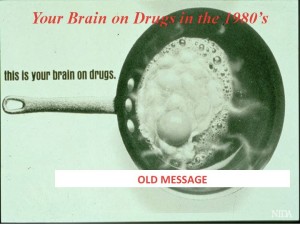Can changing our youth substance abuse prevention messages to include secondhand drinking, brain health and brain development science - especially that which occurs with the onset of puberty - help youth counter ACEs and/or embrace their decision to say, "No?"
In May of this year, I gave a presentation at the National Police Activities League (P.A.L.) annual conference titled, “'Harnessing the Power of the Brain' - Using the Brain Science of Addiction, Stress, Puberty & Brain Development to Help Youth Understand, Avoid and/or Self-Correct the Brain Impacts of ACEs (Adverse Childhood Experiences), Substance Abuse & Poor 'Decisions' & Thereby Take Control of Their Brains, Their Lives."
It was very well received and one I followed up with this post, "Why Just Say No Typically Doesn't Work," which I'm re-posting here:
Just Say No is a well-intended message and prevention effort. Unfortunately, it typically does not work with young people due to four key problems with the message. But, thanks to new imaging technologies of the past 10-15 years and the intensive, extensive studies of the live human brain in action, over time, under the influence, with mental illness, after treatment, with medications and under development that is now possible, recent research and study findings are helping to explain these problems. These findings are also helping us better understand what can be done differently to influence a young person's decision to drink or use drugs.
What's Wrong With the Just Say No Approach?
There are four key problems with the "Just Say No Message" that explain why it typically does not work.
Problem number One has to do with the way the brain develops. Because the part of the brain an adolescent needs in order to make the decision to just say no when confronted with the choice has often not started, let alone finished, developing, a young person's brain relies on the part of the brain that has developed. And that is the part that instinctively wires with the onset of puberty to push the species to take risks and turn to one's peers. That portion of the brain is on full speed ahead starting at about age 12. Unfortunately, the part of the brain that serves as the breaks on this risk-taking behavior and that can logically reason through complex decisions, such as what could wrong and why should one wait until 21, typically doesn't even start to develop until around age 16. It typically takes until one's early 20's to complete. For these brain developmental reasons, alcohol does not work the same way in the adolescent brain as it does in the brain of an adult.
"It's Time We Tell The Whole Truth About Puberty"
"Underage Drinking - How Teens Can Become Alcoholics Before Age 21"
Problem number two has to do with adolescents watching the drinking or drug use patterns of their peers, older siblings, parents, grandparents, neighbors - even the adult delivering the "Just Say No" message. These individuals may be drinking and/or doing drugs with no apparent problem (at least as far as a teen is concerned) or they may be abusing a substance, themselves. So the teen does not see the harm. The same is true of the old message in the image to the right, "Your Brain On Drugs." New science demonstrates the brain's plasticity, showing brain cells can heal and re-wire when brain health is restored (nutrition, exercise, sleep, mindfulness, help with stress or mental health issues, stopping substance abuse..., as examples).
"A Different Kind of Conversation About Underage Drinking"
"5 Things Parents Should Consider to Keep the Message Clear"
"Here's to Neural Networks and Neurotransmitters: Keys to Brain (and Therefore Emotional) Health"
"The Brain Can Change When Substance Abuse is Stopped"
Problem number three has to do with not telling teens the whole story because let's face it, teens want the "Why." (Don't we all!) To tell the whole story, we must change the message to be more along the lines of, "Understand why it's important not to abuse alcohol or drugs while your brain is developing from ages 12 - 21, understand how alcohol and drugs work in the brain and why they are so compelling to the brain brain under 21, and understand how brain development from ages 12-15, especially, will influence (or not) your decision-making capabilities." This sort of message I've found resonates with teens, and as importantly, with their parents. Because let's face it, many parents condone drinking (and sometimes drug use) - if not outright, then with a "wink-wink" - as a right of passage, something they did themselves as a teen and look how well they turned out, or something all teens do. The problem with these beliefs is that early drug or alcohol misuse may not work for their child's brain.
"Five Things To Know About Adolescents' Brain Development and [Substance] Use"
"Want to Get Through to Teens | Talk To Their Brains"
"Drugs, Brains, and Behavior: the Science of Addiction"
 And problem number four - SECONDHAND DRINKING. A key reason to say, "No," to getting drunk or taking drugs is the brain changes they cause. These brain changes result in drinking or drugging behaviors, which in turn cause secondhand drinking impacts for others. Secondhand drinking is the worry and anxiety a BFF experiences when she has to track on her drunk friend every Friday and Saturday night to make sure she doesn't wander off with some guy or climb in a car with a drunk driver or repeatedly fend off her drunk friend's inane, circular, sarcastic, argumentative, mean-spirited verbal assaults. It's what happens to the young driver who's always the DD (designated driver) and spends his/her evenings trying to keep friends from puking in his/her car, being rowdy in the back seat, insisting on music changes while he/she's trying to navigate traffic or losing his/her license or going to jail for his/her friend's open container when pulled over for a DUI check point. Secondhand drinking is the deep pain and guilt friends of a teen, whom everyone knew had a drinking or drug problem, feel when that friend dies of an overdose or experiences a serious, life-changing accident, date rape, unwanted pregnancy...., because none of them knew enough about how alcohol or drugs work in the brain, of what a friend can (and should) do in order to get their friend the help they need, of the seriousness of a young person's drinking or drug misuse problem.
And problem number four - SECONDHAND DRINKING. A key reason to say, "No," to getting drunk or taking drugs is the brain changes they cause. These brain changes result in drinking or drugging behaviors, which in turn cause secondhand drinking impacts for others. Secondhand drinking is the worry and anxiety a BFF experiences when she has to track on her drunk friend every Friday and Saturday night to make sure she doesn't wander off with some guy or climb in a car with a drunk driver or repeatedly fend off her drunk friend's inane, circular, sarcastic, argumentative, mean-spirited verbal assaults. It's what happens to the young driver who's always the DD (designated driver) and spends his/her evenings trying to keep friends from puking in his/her car, being rowdy in the back seat, insisting on music changes while he/she's trying to navigate traffic or losing his/her license or going to jail for his/her friend's open container when pulled over for a DUI check point. Secondhand drinking is the deep pain and guilt friends of a teen, whom everyone knew had a drinking or drug problem, feel when that friend dies of an overdose or experiences a serious, life-changing accident, date rape, unwanted pregnancy...., because none of them knew enough about how alcohol or drugs work in the brain, of what a friend can (and should) do in order to get their friend the help they need, of the seriousness of a young person's drinking or drug misuse problem.
"Secondhand Drinking Prevention"
It's time we re-think the "Just Say No" message and revise it to address these four key problems, because let's face it, if the message worked, there would be no (or at least far fewer) teen drug and alcohol problems.





Comments (0)